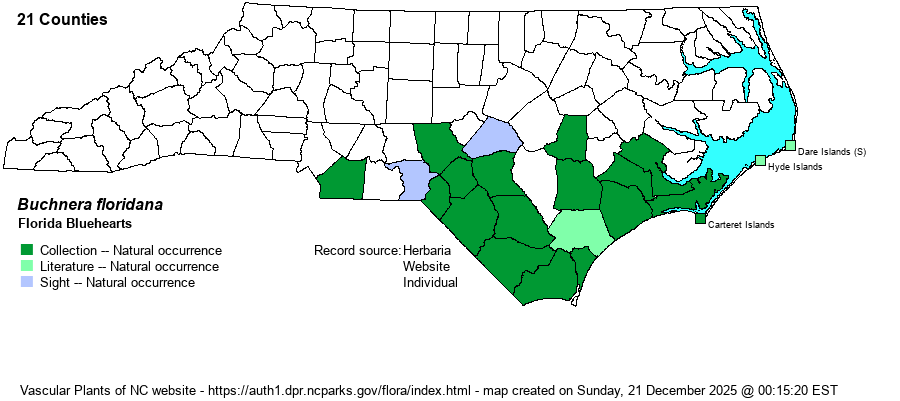| Author | Gandoger | |
| Distribution | Found in the southern 40-45% of the Coastal Plain, from southern Dare County (Cape Hatteras vicinity) southwest to include the Sandhills region. Also barely west to the extreme southeastern Piedmont (Union County).
This is a Southeastern species that ranges north to southeastern NC, south to southern FL, and west to TX. The range essentially does not quite overlap with the more Northern and Midwestern B. americana. | |
| Abundance | Infrequent in the lower Coastal Plain, but generally rare to uncommon in the more western Coastal Plain, including the Sandhills; very rare in the southeastern edge of the Piedmont. | |
| Habitat | This is a species of slightly damp, sunny ground, normally where sandy and with some moisture. Though perhaps originally a species of pine savannas, flatwoods, and seepage "bogs", many populations today are along grassy roadsides or in powerline clearings. The population in NC and elsewhere has certainly declined owing to fire suppression and loss of habitat. | |
| Phenology | Blooms from April to October, though mostly from June to September; fruits from May to November. | |
| Identification | This is a slender and unbranched species, growing to about 1.5 feet high, with a scattering of paired, opposite leaves, mostly on the lower portions of the stem. The leaves are wider above the middle, oblanceolate to rarely elliptic, about 2 inches long and about 2/3-inch wide. The leaves have few teeth, barely noticeable. The top 4 inches of the stem contains a spike or raceme of small lavender-purple flowers, each tubular at the base but with 5 spreading petals that are squared-off at the apex. Each flower, however, is only about 2/5-inch across. Despite the smallish size of an individual flower, the plant is still quite striking in bloom, as the flower cluster is held well above the leaves, and as there are not that many 5-petaled lavender-purple flowers that look similar to it. You must be very careful in separating this from B. americana, at least in the lower Piedmont; a few such specimens have been misidentified. The latter species is taller, has larger flowers that average more blue in color, and occurs over high pH soils. However, those characters can be tricky to use; thus, leaf characters are better; that species has leaves wider below the middle, more and/or sharper teeth, 3 main veins on most leaves as opposed to one main vein and 2 minor ones, and leaves that are acute or tapering, as opposed to rounded in B. floridana. Even though B. floridana now occurs in man-opened habitats, such as roadsides, it is still somewhat difficult to find and is always exciting to find plants in bloom. | |
| Taxonomic Comments | Some references consider this within B. americana, and when doing so, usually do not even consider it as a variety or subspecies. Thankfully, most references consider this as a valid species.
| |
| Other Common Name(s) | Savanna Bluehearts | |
| State Rank | S3 | |
| Global Rank | G5 | |
| State Status | | |
| US Status | | |
| USACE-agcp | FAC link |
| USACE-emp | FACU link |

